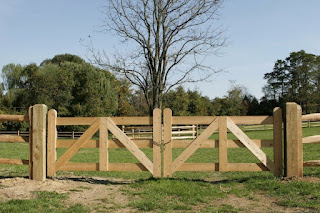How to Choose the Right Materials for Your Post and Rail Fence
Tagged as: .
When it comes to adding a classic touch to your property, few fencing options are as timeless and charming as post and rail fences. Whether you're enclosing a pasture, defining a property boundary, or simply adding a touch of rustic elegance to your landscape, Cypress post and rail fence can be the perfect choice. However, with various materials available, choosing the right one can be a daunting task.
Here's a comprehensive guide to help you choose the right materials for your post and rail fence:
1. Wood
Wood is the traditional material for post and rail fences and continues to be a popular choice for its natural beauty and rustic appeal. Cedar and pressure-treated pine are the most common wood options for post and rail fences.
Pros:
- Natural beauty and rustic charm
- Easily customisable
- Environmentally friendly
Cons:
- Requires regular maintenance (staining, painting, or sealing)
- Susceptible to rot, decay, and insect damage
2. Vinyl
Vinyl post and rail fences offer the look of traditional wood fencing without the maintenance hassles. Made from PVC (polyvinyl chloride), vinyl fences are durable, weather-resistant, and available in a variety of colours and styles.
Pros:
Low maintenance (no painting or staining required)
Resistant to rot, decay, and insect damage
Long lifespan
Cons:
- Higher upfront cost compared to wood
- Limited colour and style options

3. Metal
Metal Cypress post and rail fence, typically made from aluminium or steel, offer strength, durability, and a sleek, modern look. While less common than wood or vinyl, metal fences can be an excellent choice for properties where security is a concern.
Pros:
- Strength and durability
- Low maintenance
- Excellent security and longevity
Cons:
- Higher upfront cost
- Limited style options
- May not suit every aesthetic
4. Composite
Composite post and rail fences combine wood fibres with recycled plastic, offering the natural look of wood with the durability of plastic. Composite fences are resistant to rot, decay, and insect damage, making them an excellent low-maintenance option.
Pros:
- Low maintenance
- Resistant to rot, decay, and insect damage
- Environmentally friendly
Cons:
- Higher upfront cost compared to wood
- Limited colour and style options
Factors to Consider:
- Budget: Determine how much you're willing to spend on your fence. While wood may be more affordable upfront, vinyl, metal, and composite fences offer long-term savings due to their low maintenance and durability.
- Aesthetic Appeal: Consider the overall look and style you want to achieve. Each material offers a different aesthetic, so choose one that complements your property's design and landscaping.
- Maintenance Requirements: Decide how much time and effort you're willing to invest in maintaining your fence. While wood fences require regular maintenance, vinyl, metal, and composite fences are virtually maintenance-free.
- Durability and Longevity: Take into account the climate and environmental factors in your area. Choose a material that can withstand the elements and will last for many years to come.
Final Words
By considering these factors and weighing the pros and cons of each material, you can choose the right materials for your post and rail fence that best suit your needs, budget, and aesthetic preferences. With the right materials, your Cypress post and rail fence will not only enhance the beauty of your property but also provide security, privacy, and peace of mind for years to come.
Source: https://thewoodprojectaus.blogspot.com/2024/05/how-to-choose-right-materials-for-your.html